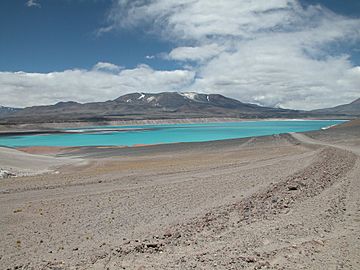Falso Azufre facts for kids
Quick facts for kids Falso Azufre |
|
|---|---|

Falso Azufre volcanic complex and Laguna Verde.
|
|
| Highest point | |
| Elevation | 5,906 m (19,377 ft) |
| Geography | |
| Location | Argentina and Chile |
| Parent range | Andes |
| Geology | |
| Mountain type | Complex volcano |
| Last eruption | Unknown |
Falso Azufre is a large complex volcano located right on the border between Argentina and Chile. It is a huge mountain that reaches a height of about 5,906 meters (19,377 feet) above sea level.
Contents
About Falso Azufre
Falso Azufre is a very long volcano, stretching from east to west. It has many different features, like craters and lava domes. Most of its craters are about 300 to 600 meters wide. The main crater is even bigger, measuring about 1 by 1.3 kilometers across.
The highest point of the volcano is called Cerro Falso Azufre. It is located on the western side, in Chile. This part of the volcano has mostly produced ash and rock fragments from its craters.
Parts of the Volcano
The eastern part of Falso Azufre, located in Argentina, is probably the newest section. Here, you can find two lava domes and two cones, which together form a smaller volcano called Dos Conos. Some of the lava flows from Dos Conos are very long, reaching up to 7 kilometers (4.3 miles).
The oldest part of Falso Azufre is known as the Kunstmann edifice. It is located on the northwestern side. The Kunstmann volcano has a large scar, about 3 kilometers (1.9 miles) wide. This scar was formed when a part of the volcano collapsed. Falso Azufre is one of the biggest volcanoes in its area, covering about 387 square kilometers (149 square miles) at its base.
What Falso Azufre is Made Of
Most of Falso Azufre is made up of large, blocky lava flows. Nearby volcanoes include Nevado San Francisco and the Laguna Amarga caldera. The rocks from Falso Azufre are mostly trachyandesite, andesite, and dacite. These rocks contain minerals like hornblende and pyroxene.
Volcanic Activity
Scientists have studied the age of the rocks at Falso Azufre. The oldest rocks, found at the Kunstmann part, are between 3.5 and 2.9 million years old. Most of the other rocks on Falso Azufre are less than one million years old. The western part of the volcano has older rocks, while the eastern part has younger rocks, some less than 400,000 years old.
The very youngest lava flow found is from Dos Conos, dating back about 160,000 years ago. Because of these ages, Falso Azufre is considered an extinct volcano. However, it's always possible that some activity could happen in the future, even if it's unlikely.
Location and Impact
Falso Azufre is part of the Central Volcanic Zone of the Andes mountains. This zone has about 110 other volcanoes that have been active in the last 2.6 million years. Falso Azufre is in the southern part of this volcanic zone.
Other volcanic zones in the Andes include the Northern, Southern, and Austral Volcanic Zones. We don't know much about the past eruptions of many of these volcanoes. Only a few eruptions have been recorded in history, like one at Ojos del Salado in 1993.
Because Falso Azufre is in a remote area, it doesn't pose a big danger to people. However, any future eruptions could affect air traffic flying over the region. Also, a major road is located close to the volcano.
See also
 In Spanish: Falso Azufre para niños
In Spanish: Falso Azufre para niños
- Cerro Torta
- List of volcanoes in Chile
- List of volcanoes in Argentina

